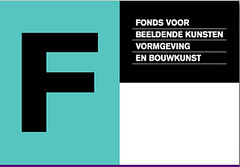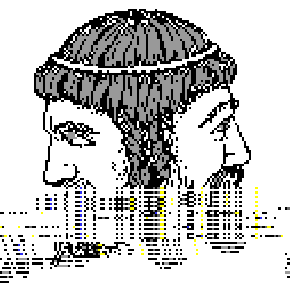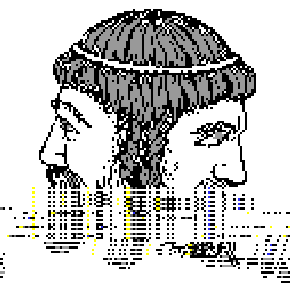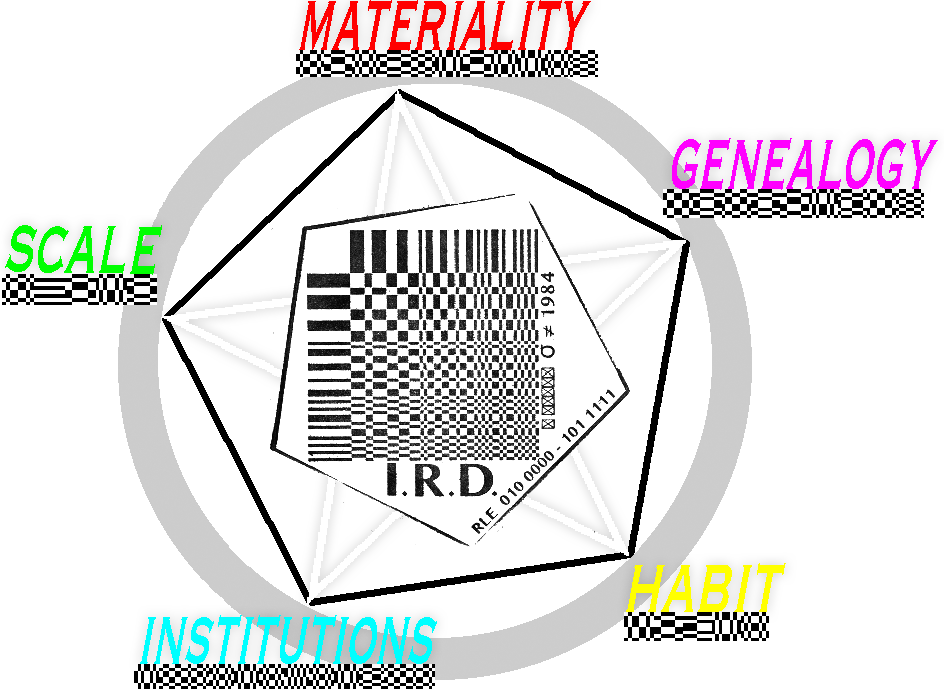Download Monglot
Monglot works on MACOSX some 10.5s and 10.6 - We had no chance to program it for other OSs'. But I really hope some time we can.
Why make another glitch software
About half a year ago I logged into the "Glitch Art"-Flickr-pool to find inspiration for a 5 day workshop on glitching, that I was to give at the AKI (an Art School here in The Netherlands). Nothing seemed to have changed since the last time I logged in; the pool that once seemed so progressive, suddenly felt cold and boring, standardized, slow and in a general lack of inspiration. I found the images not interesting, they did not break any order and definitely not altered my state of mind or induced some kind of new thoughts. In hindsight I would summarize it as a collection of random pretty-girls-or-cats-as-subject (because that will never bore) - images, obfuscated by bright macro-blocks holding wrong luma and chroma values - further 'corrupted' by anti-aliasing, blocking, checker boarding, and other forms of distortion (yes, I could make the cool a-to-z artifact-list --- humor me). 5. Realize that the gospel of Glitch Art also tells about new standards implemented by corruption.Not all Glitch Art is progressive or something new. The popularization and cultivation of the avant-garde of mishaps has become predestined and unavoidable. Be aware of easily reproducible glitch effects, automated by softwares and plug-ins. What is now a glitch will become a fashion.**
What I found in the Glitch Art Flickr pool were images opposing my original definitions of glitch (a short-lived fault in a system, inducing affects like surprise or shock) and Glitch Art (art that radically revalues normative knowledge, values and expectations). Instead, the pool underpinned a more ruptured discourse of Glitch. It showed an ironic, conflicted compromise between what I think of as the 'Other' form of Glitch (which is progressive or against the grain) and a commodified, superficially stylized form of glitch art (which is driven by the colonizing power of an aesthetically driven economy).
This double edged sword of todays Glitch Art has cut deep into the glitches' origins, forcing us to return back to our initial definitions. Glitch art as a style recalls Homi Bhabhas': "almost the same, but not quite" or a 'mimicry of digital slippage'; the real glitch of Glitch Art has slowly diminished into a virtual signifier, while the popular, commodified side of glitch has become a primal part of the new glitch-economy. This has left me thinking if in my Glitch Studies I should pay more attention to this 'other side of the coin'.
For the workshop at the art school I finally decided to teach about the materiality of file formats; their different languages, slang or dialects and what specific qualities, rules and rhetorics (slang poetry) can be exploited as a generative matter to create new images (a practice closely related to databending). I named the workshop "A Vernacular of File Formats" and showed different compression based artworks I have found over time while supplying the students with methods and tools to create their own format based research, and finally artworks.
One of the troubles I ran into during the workshop was that the tools I had were not ideal for such a workshop; with every other file format we set out to manipulate we had to switch softwares (which between the different OSs' on the students computers became a real *pain*). Because of all these troubles I felt it would be best that any future workshop would be accompanied with some basic visual support. I started working on the Vernacular of File Formats - a pdf that was first exhibited at GLI.TC/H and that later became a series of images. As I wrote back then, in this pdf I set out to make what once was cool, hot (think McLuhan) to emphasize the double edged sword of glitch. I hoped (wished) that in this way, the banal graphic effects that have by now (at least to me) lost all their extraordinary, revelatory potential, would be demystified and that subsequently more artists would start to think about how they can develop another dimension in their art (besides glitch just being a material research or aesthetic element). Of course, serendipitously, after releasing the pdf I got about ten emails asking me about specific technicalities of working in the different file-format cases…
Finally, during my residency in Sao Paolo, I started working on the Glitch Studies Manifesto-movie (that is still in production), of which the Vernacular of File Formats is an undeniable section. I spoke to Johan Larsby (who previously coded Swutits) about the lack of a software that can help me both in teaching and in the creation of images (and possibly movies) that would complement Glitch Studies, the Manifesto and the other work I had done in the past. This is when the Monglot project really started.
About Monglot (order and progress // chaos and destruction)
The name Monglot is a degeneration of the terms Mongrel and Monoglot (the term also references Homi Bhabha's "forked tongue" of colonialism and my idea of Glitch speak).
*/
Mongrel: the offspring of varieties of a species, mixed background, bastard, or an imperfect crossbreed
Mongrel: the offspring of varieties of a species, mixed background, bastard, or an imperfect crossbreed
Monoglot: knowing only one language; monolingual.
*/
*/
The Monglot software generates glitch images by mashing two languages in one final image; first of all the visual language of the image and secondly the image-data encoded in the language of the compression, that erupts over the surface of the former. This is how common glitch aesthetics like fragmentation, grain, ghosting, heterodynes, interlacing, jitter, jaggies, (…) posterization, pixelating, quantization error, ringing, staircase noise, scan lines (…) are being generated (mimicked?) and come to the surface.
Monglot aims to show the ambivalence (cool vs. hot) and the double articulation (encoding vs. image data) of (File Format-based) Glitch Art. The images generated in the software are ironically standardized by repetition and as such exist as a compromise in-between cool and hot glitches.
Monglot can be used to learn and research different file formats and their behaviors. This process of experimenting with different file types and their surprising effect are (I hope at least) part of this software. The thinking and interpreting that this process calls for (opens up) is a field that comes close to a "cool medium". Which is not the case with many other softwares that only accept one or 2 different file formats for experimentation and that actually carry a standard instead of opens the standards up for questions. (in most softwares the endproduct is the focus, not the /experimental/ generative part).
This makes Monglot exists as a glitch discourse in-between the lines, against the rules and within them, which is where I think we should look for the discourse of Glitch Art and Glitch Studies.
Monglot can be used to learn and research different file formats and their behaviors. This process of experimenting with different file types and their surprising effect are (I hope at least) part of this software. The thinking and interpreting that this process calls for (opens up) is a field that comes close to a "cool medium". Which is not the case with many other softwares that only accept one or 2 different file formats for experimentation and that actually carry a standard instead of opens the standards up for questions. (in most softwares the endproduct is the focus, not the /experimental/ generative part).
This makes Monglot exists as a glitch discourse in-between the lines, against the rules and within them, which is where I think we should look for the discourse of Glitch Art and Glitch Studies.
By normalizing (standardization through rules and repetition) the glitched states of the image the maker develops (new) knowledge of the compression language of the image. At the same time Glitch Art (as progressive and against the grain) becomes a virtual entity (a concept that is only referenced). Monglot thus imposes failure strategically, as a norm, to fork itself from the realm of Glitch Art.
Monglot Manual
Monglot is best used next too the Vernacular of File Formats.
The Monglot software allows you to insert random hex-data into an image, while allowing you to transcode the same image into different file formats. This will make the effect of the insertion of the same random data on the same image encoded in a different image file formats apparent.

The interface
* The Glitchspeak number is the iteration of random data you want inserted into your image data. If you re-click the Glitchspeak button with the same number inserted before you click EAffect! you will get the same random data inserted into your image and thus the same outcome (depending on if you used the same image or the same vernacular).
* Replace √ allows you to replace one value in the hex-code with another (if you want to do this, you will have to √check√ the Transgress button)
* The Progress <-> Order slider allows you to set the amount of random image data inserted in your image. Notice that complete order and complete progress have some ironic outcomes.
* The Vernacular drop down menu allows you to choose in what file format you would like your image to be transcoded. Unfortunately there are only a few file formats freely available in the Cocoa image library and these are the ones that are available in Monglot. In the future I hope we can change these and insert more options. To get different outcomes. If you want to play with different outcomes and file formats now, you have to open an image that is already encoded in a different image file format (via for instance photoshop or preview). Try all the different encodings of for instance PNG (interlaced and non-interlaced) or TIF (compressed and non compressed) and learn about the differences these encodings make.
If you want to use the original file format encoding, choose Vernacular and open your image again.
If you want to use the original file format encoding, choose Vernacular and open your image again.
* Batch √ allows you to make a batch process (to make a number of different glitch-iterations of the same image).
* Conserve √ allows you to save the images in a folder called Monglot. Make sure you empty this folder regularly otherwise you will fill up your harddrive (I have managed to write 70GBs of data in under a minute when I used the Monglot batch processes).
* EAffect is the button you click to make the 'magic' happen.
EAffect is an ironic reference to the discourse of glitch that has been standardized (undermined) by the abuse of words like Effect, Affect, Transgress, Politics while the theorists don't even explain (or probably know) what they really mean when they use them.
EAffect is an ironic reference to the discourse of glitch that has been standardized (undermined) by the abuse of words like Effect, Affect, Transgress, Politics while the theorists don't even explain (or probably know) what they really mean when they use them.
* FIT is the button that is supposed to make the image FIT, but right now it just stretches in one dimension (this is a known Bug-hug).
* GFD (Glitch File Directory - to be found in the toolbar) allows you to make animations (and movies, for instance when you use it in combination with Quicktime 7). Export your video to an image sequence and load this file directory via GFD in Monglot. Save the glitched images in another file directory and open this directory as an image sequence.
/////////////////////////////////////////////////////
Monglot is programmed by Johan Larsby. He did a great fantastic job for the very little time we had - because unfortunately-fortunately he got a new work-contract (and now he can only code for his employer). So... Johan and I were forced to cut the production/programming on Monglot short. I worked to make the software presentable (in this beautifully difficult interface), but it is still full of little and bigger bugs (but what is a glitch software without bugs?). I hope some time in the future we can make it better and develop it further. For now it is a conceptual software.
Monglot works on some 10.5s and 10.6 - We had no chance to program it for other OSs'. But I really hope some time we can.
/////////////////////////////////////////////////////Shout outs to brother projects (uncomplete..)
Benjamin Gaulon: Corrupt™
Károly Kiripolszky: ByteMolester 0.9 (RIP)
Iman Moradi, Ant Scott and Dimitre Lima: glitchbrowser (RIP)
Youpy: Glitchmonkey
Johan Larsby: Swutits
Sven Konig: Appropirate! / Download finished!
UCNV: AVI GLITCH & GlitchPNG
Jon Satrom & Ben Syverson: Satromizer
Nick Briz: Glitch dvd tutorial project
Stallio: for all his tutorials
Kim Asendorf: Screenfuck
Datamosher: Datamosh tutorial
Vade&bangnoise: too many things



Monglot is developed with the support of the São Paulo Museum of Image and Sound, Stichting Impakt and the BKVB.





5 comments:
loving this. where do i put the folder called monglot for conserve to work?
I think it makes a folder automatically, maybe search for the folder in the finder.
Is there a way to save a picture without using the auto-save conserve option? I mean to do it manually...
No it autosaves always, but you can always delete; thats the law of software universe : )
why not for windows :(
Post a Comment